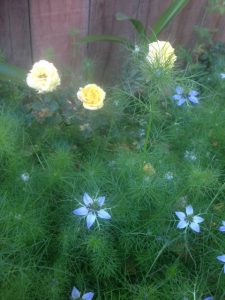Favorite Drought-Tolerant Reseeders
With extreme drought across the West, my attitude has changed toward plants that return each year, under grueling conditions, to grow in my yard. I live in Jamestown, an oak savannah ecosystem below 1500 feet in elevation (translation: hot, flat and dry).
I couldn’t help noticing that—even with our lack of “normal” winter precipitation and our warm spring that started in January—there were annual plants that grew bountifully and bloomed exuberantly. Even though these species could never be referred to as “drought-tolerant,” I consider them foolproof because they return every year, no matter what. Your conditions and results may vary, but if you are interested in plants that reseed generously (I may once have considered them weedy or a pain) and can be counted on to reliably provide flowers, food or foliage, here are my favorites for your consideration:
Arugula. Once you plant arugula, you always have arugula. In a large container near the patio for quick picking, the leaves add spicy zest to salads. A cool-season crop, with a little regular water and a little shade, arugula hangs in there for months. Naturalized in the middle of my backyard, it grows in full blazing sun with no additional water. When mowed as part of the lawn, it imparts a pleasant spicy scent to the air. Arugula, a member of the Brassicaceae or mustard family, blooms with a characteristic creamy-yellow four-petaled flower (the family name used to be Cruciferae in reference to the cross-shaped flower) which is very attractive to pollinators. I have seen birds harvest seeds from dried seed pods. When the plant has dried, it’s easy to rough-chop stalks into mulch and scatter seed back into the container for another year’s growth.
Miner’s Lettuce. One spring I found a tiny leaf of miner’s lettuce (Claytonia perfoliata) under a live oak tree. Careful weed-eating produced an exuberant patch the next year. Each year since it has moved to a different part of my yard following its own unknown-to-me path. This year it colonized my vegetable garden and the back corner of my yard near the compost bin, growing almost two feet tall! I have experimented with different treatments, from leaving it undisturbed to mowing it regularly. Left on its own, it can create a smothering mat of high-moisture vegetation that crowds out anything else. However, repeat mowing keeps it low-growing and it continues to put out small leaves that are attractive and green into the summer. I love that my spring and early summer salads are created on a base of miner’s lettuce mixed with arugula, both repeat growers that require almost nothing from me.
Love in a Mist. A Master Gardener friend gifted me with Nigella seeds when I was first trying to establish a landscape. Again, once you plant them you will always have them (however, they refuse to grow in my hot-as-Hades front planter area that receives 14 hours of summer sun). In spring, the foliage is lacy, fernlike and delicate, followed by blue-to-white star-shaped single or double flowers. Interesting-looking seed pods—which my granddaughters love to crush—drop tiny seeds once their life cycle is complete. Mowed, dry stems can be tough on little bare feet, but the balloon-shaped seed pods make an interesting border in out-of-the-way places.
Enjoy these annuals that reward us so richly for so little effort.
Rebecca Miller-Cripps is a University of California Cooperative Extension Master Gardener of Tuolumne County.

